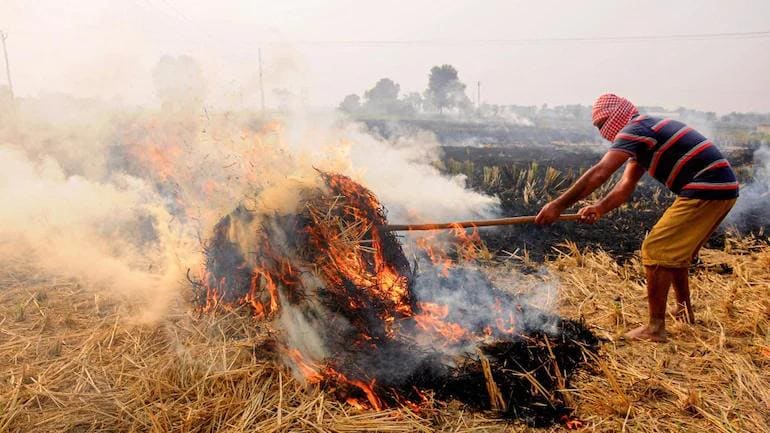A bio-decomposer developed by a research institute and a pesticide firm has the potential to make North India’s pollution woes a thing of the past. Sometimes a breakthrough seems too good to be true. A solution is in sight to end the terrible air pollution that suffocates Delhi-wallahs every October and November when farmers in Punjab and Haryana burn 12 million tonnes of stubble from their newly harvested rice crop. Farmers have a gap of just a few weeks between harvesting of rice and sowing of winter wheat, so they burn the stubble to clear their fields.
Once harvesting was done manually by workers who left very little stubble. But now harvester-combines do the harvesting and leave six to ten inches of stubble. Burning this destroys nutrients and worsens the soil even while killing and maiming people with air pollution. But farmers say they have no economically viable alternative. Burning has been declared illegal, but farmers ignore the law and politicians dare not act against all farmers.
So, what is the new breakthrough? Some years ago, the Indian Agricultural Research Institute developed a bio-decomposer using eight fungi. When sprayed in a technically sound manner, it decomposed stubble into green manure in a few days. This had the potential to end stubble burning and enrich the soil. But the original process required mixing it with a chickpea solution for fermentation before spraying. The logistics of getting the bio-decomposer to farmers, fermenting and spraying it in the short window of time between crops proved too formidable.
Now, a joint development of the bio-decomposer by the IARI and UPL, India’s largest pesticide company, has overcome the obstacles. UPL has developed a process to mass-produce the decomposer in powder form that can be transported to warehouses across target areas, ready for mixing with water and spraying when the window of time appears. UPL has also designed machines for spraying the decomposer. Each machine has two hollow arms ten feet long with spraying nozzles every foot, adding up to 20 nozzles. A worker manually spraying the solution can cover only a few acres per day. But each machine covers hundreds of acres per day. Around 700 machines were deployed in the 2021 season, and 3,000 will be deployed in the coming season.
In October-November 2021, the project covered 4.2 lakh acres in Punjab and Haryana. The plan is to target 20 lakh acres which should reduce pollution significantly. UPL hopes in a few years to cover almost the entire 60 lakh acres under rice in the two states, ending air pollution altogether.
Expanding acreage so fast is feasible since UPL provides the service free of charge, so farmers queue up to participate. The company spent Rs 50 crore on spraying in the first season and is prepared to spend hundreds of crores to fully cover the two states. How can it afford to do this free of charge?
The answer is that it will earn carbon credits from the emissions trading scheme of the Kyoto Protocol and Paris Agreement on climate change. Under the scheme, companies with pollution above specified limits have to buy offsetting carbon credits in the international market from other entities that have cut emissions. Hopefully carbon credits will enable UPL to make a profit, but that is not guaranteed.
In 2021, spraying is estimated to have reduced emissions of carbon dioxide by 1.04 million tonnes, ash by 141,612 tonnes, carbon monoxide by 42,697 tonnes, particulate matter by 2,135 tonnes and sulphur dioxide by 1,423 tonnes. It will take two years for the documentation and data to be submitted and approved. UPL will not get any revenue through carbon credits till late 2023.
The project is a major exercise in co-ordination. It starts with outreach, spreading awareness of the with outreach, spreading awareness of the Satellite data helps identify farmers who are confirmed stubble burners. Field data is analysed to organise farmers into clusters for spraying. Stocks of decomposition powder are built up in every cluster for use when needed. Using smartphone apps, machines are scheduled to reach each registered farmer at an agreed time. Post-spraying satellite studies showed a 92% success rate: only 8% of farmers still resorted to burning.
I met several of the farmers covered in the 2021 spraying season. They all lauded the efficiency of operations: appointments were properly scheduled and adhered to. They said the conversion of stubble into green manure enriched the soil and helped reduce urea application by up to 20%. This improved profitability and soil quality.
Scaling up the project from 4.2 lakh acres last season to 20 lakh acres next season poses huge logistical challenges. Nobody should be surprised if there are some glitches in curbing pollution. But there is suddenly a lot of light at the end of the tunnel.
This article was originally published in The Times of India on March 19, 2022.
Read more: India’s arduous exit from easy money policy
Post Disclaimer
The opinions expressed in this essay are those of the authors. They do not purport to reflect the opinions or views of CCS.






